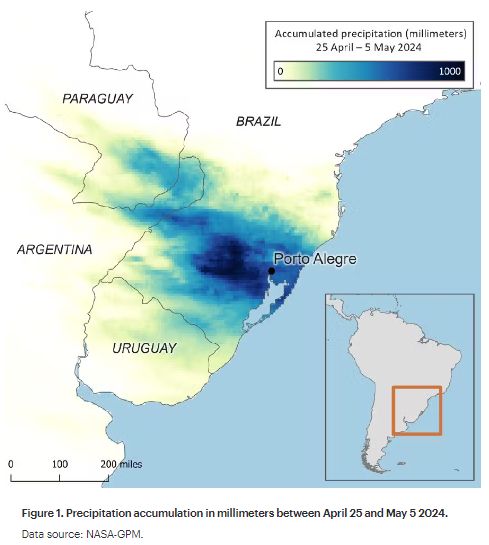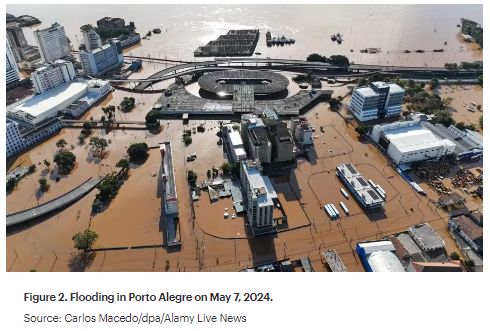Catastrophic flooding in Brazil in April and May was a stark reminder of the compound effect of El Niño and climate change. Unprecedented rainfall led to devastating flooding across Rio Grande do Sul.
Record-breaking rainfall in the Rio Grande do Sul (RGDS) province of Brazil — equivalent to three normal months of rainfall in a two-week period — caused flooding over an area the size of the U.K. (Figure 1).

Two-week rainfall accumulations reached almost 1,000 millimeters in some parts of RGDS, and the state's capital, Porto Alegre, registered 327 millimeters of rainfall in less than a week at the end of April (Figure 2).

The flooding has also been long-lasting, persisting for almost all of May with flood depths reaching 5 meters in some locations.1 Economic losses are expected to exceed 22 billion Brazilian Reals (US $4 billion).
More than 580,000 residents were displaced,2 over one-third of RGDS's population lost access to running water,3 hundreds of thousands were without power for weeks, and 170 fatalities were reported. The flooding also disrupted health services and infrastructure, and outbreaks of waterborne diseases, particularly leptospirosis, compounded the challenges faced by health authorities and emergency responders in the region.
RGDS, a key producer of rice, soy and livestock, is vital to the country's economy. Although some crops were harvested before the floods, storage facilities were likely damaged; many livestock were lost, and remaining animals face feed shortages.4
The regional airport in Porto Alegre was closed for several days, and local transport networks have been disrupted by flooding and landslides. Additionally, the floods disrupted supply chains throughout the region. For example, major auto manufacturers such as Chevrolet and Volkswagen have reported production slowdowns or stoppages.
Compound impact of El Niño and climate change
Both the phase of the El Niño-Southern Oscillation (ENSO) and climate change are thought to have contributed to the severity of the recent flooding. The El Niño phenomenon, characterized by warmer than-average sea surface temperatures in the central and eastern tropical Pacific Ocean, facilitates the transport of warm, moist air toward southern Brazil. This increased moisture supply can increase the intensity and duration of rainfall events, which leads to an elevated risk of flooding.5 Compared with a neutral ENSO phase, the recent El Niño phase is estimated to have increased the likelihood of this extreme rainfall event by two to five times and its intensity by 3% to 10%.6
El Niño alone isn't to blame for the severity of the recent flooding. Scientists have found that human induced climate change doubled the likelihood of this event and increased the intensity by 6% to 9%,7 aligning with more general future projections of increases in both flash flooding and river flooding. This trend is already evident in southeastern Brazil, where annual precipitation and high-intensity events are increasing.8
Deforestation, urbanization and aging infrastructure
Alongside climate change and El Niño, social factors also played a role in exacerbating the disaster's impacts. Deforestation, urbanization encroaching on flood-prone land and inadequate maintenance of flood protection infrastructure in cities such as Porto Alegre may have amplified the impact of the floods. Forecasts and warnings of the floods were available nearly a week in advance, but the warnings may not have reached all of those at risk, and the public may not have understood the severity of the potential impacts or how to respond appropriately.
While improved risk assessments, warnings and flood defenses may save lives and reduce damage, the low insurance penetration rates — around 30% for homes in southern Brazil 9 — mean that many uninsured residents may not be able to afford to rebuild after the recent flooding. Against the backdrop of increasing flood risk under climate change, some local people say they have no desire to return to homes they believe are unsafe, prompting discussions by officials about the once-inconceivable relocation of entire communities to higher ground.
Implications for risk managers
Risk assessment and early warning
Conduct comprehensive flood risk assessments that consider the impacts of climate change, deforestation and urbanization. Focus on high-risk areas, such as urban settlements with poor drainage. Improve communication strategies to ensure the public understands potential impacts and knows how to respond.
Infrastructure risks
Identify, quantify and mitigate systemic risks, including potential failures of flood defenses and key infrastructure, especially in densely populated areas such as Porto Alegre.
Risk management and transfer
Collaborate with natural catastrophe risk specialists to manage flood risks through innovative risk transfer solutions, promote higher insurance penetration and quantify climate change impacts on flood risks.
Footnotes
1. NASA. Southern Brazil Submerged. (2024).
2. United Nations Office for the Coordination of Humanitarian Affairs. Brazil: Floods and landslides, update. (2024).
3. World Weather Attribution. Climate change, El Niño and infrastructure failures behind massive floods in southern Brazil. (2024).
4. United States Department of Agriculture Foreign Agricultural Service. Brazil: Unprecedented floods in Rio Grande do Sul threaten Brazil's agricultural output. (2024).
5. Cai, W et al. Climate impacts of the El Niño–Southern Oscillation on South America. Nat Rev Earth Environ 1, 215–231. (2020).
6. World Weather Attribution. Climate change, El Niño and infrastructure failures behind massive floods in southern Brazil. (2024).
7. IPCC. Sixth Assessment Report. (2023).
8. Marengo, J.A., et al. Heavy rainfall associated with floods in southeastern Brazil in November–December 2021. Natural Hazards 116, 3617–3644. (2023).
9. Fitch Ratings. Heavy rains expected to have limited impact on Brazilian insurers. (2024).
The content of this article is intended to provide a general guide to the subject matter. Specialist advice should be sought about your specific circumstances.



